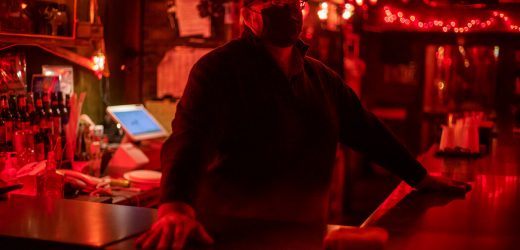The bar scene so central to the city’s economy and allure is about to become the stage for an unusually muted and bittersweet celebration.
Andrew Ledford has worked at Snake and Jake’s Christmas Club Lounge, a renowned late-night bar in New Orleans, for more than 20 years. During the pandemic, he closes the bar at 11 p.m., an hour before his work shift used to begin.Credit…L. Kasimu Harris for The New York Times
Supported by
By Brett Anderson
NEW ORLEANS — Last January, Polly Watts estimated how much alcohol she would need to make it through Mardi Gras at her bar, Avenue Pub — and then ordered considerably more than that. It’s a practice she and other bar owners here use to lock in savings that many liquor companies offer in the early months of the year.
“We had an Armageddon-level liquor stock,” Ms. Watts said. “It usually lasts us a few months.”
New Orleans has again entered Mardi Gras season — the big finale, Fat Tuesday, is Feb. 16 — and Ms. Watts, like many bar owners, has yet to sell much of the alcohol she purchased a year ago, just before the pandemic halted the city’s famous nightlife as the high season for festivals and tourism was set to begin. She doesn’t expect to go through her overstock of vodka, whiskey and beer anytime soon, even though Avenue Pub is on St. Charles Avenue, a main route for most of the large Mardi Gras parades.
That’s because this year’s official parades have been canceled. The balls, parties and other events that make up “the largest free party on earth” violate Covid-19 restrictions, which early this month were raised in New Orleans to levels not seen since the start of the pandemic, when the city struggled with one of the highest coronavirus caseloads anywhere.
Mardi Gras 2020 is remembered locally as the last gasp of pre-Covid normalcy, as well as an accelerant of the virus’s spread. So few people here expect this year’s edition to be anything like normal. It can’t be.
Infection rates in the city are at near-record levels. Current restrictions will be re-examined at the end of the month, said Sarah Babcock, director of public policy and emergency preparedness for the New Orleans Health Department. “What activities are going to be allowed on Mardi Gras is really dependent on what New Orleanians do today,” Ms. Babcock said. “But the Mardi Gras that the nation thinks of, the picture they have, is not going to happen.”
Still, Mardi Gras, a holiday with Christian (and pagan) underpinnings, can’t be canceled. “People are going to find a way to celebrate,” Ms. Babcock said. And in the absence of traditional programming, the focal point is likely to be the bars that showcase the music and drinking cultures so central to the city’s economy, identity and allure.
These businesses, which have been as damaged by the pandemic as any sector of the city’s life, face a holiday that embodies New Orleans’s spirit — the capacity for joy, the sense of community, the embrace of art and excess — in a year when no one knows what form the celebration will take, at a time when summoning that spirit could cause harm.
The bar scene here, which not even Hurricane Katrina fully shut down, has been brought to its knees by the pandemic, but it hasn’t been snuffed out. As current regulations forbid bars without food permits to serve indoors, the activity has largely moved outside, aided by relatively mild winters and laws that allow public consumption of alcohol. (Bars with food permits can serve indoors at 25 percent capacity, but can sell alcohol only with food. Mask-wearing and social distancing have been required in New Orleans since early in the pandemic.)
Serving the tourists who are bound to join costumed locals on the streets may amount to little more than selling to-go drinks and food for customers to carry as they stroll. At a news conference on Monday, Mayor LaToya Cantrell welcomed visitors for Mardi Gras while commanding them to obey pandemic restrictions, “so our residents and our folks at the forefront of hospitality are safe.”
Tom Thayer, the owner of d.b.a., a music club in the Faubourg Marigny neighborhood, is considering recruiting musicians to play outside his club on Frenchmen Street, a live-music corridor. His decision will depend on what happens with infection rates.
“Having done almost no business since last March, it’s very tempting to try and grab the money,” said Mr. Thayer, 54, “but not at the risk of prolonging this virus.”
Ms. Watts, 55, plans to decorate the Avenue Pub to resemble a Mardi Gras float, as many locals have already done to their homes. “I just want something that will make people smile when they drive by, even if they don’t stop,” she said.
The ban on close public contact made necessary by the pandemic has rendered it all but impossible for the city’s famed drinking businesses — from its historic music clubs and neighborhood beer joints to its vintage and modern temples of exacting cocktails — to be their true selves.
The 11 p.m. closing time in place for much of the pandemic has been jarring, not least for veteran bartenders like Chris Hannah, an owner of Jewel of the South, a bar and restaurant in the French Quarter.
Mr. Hannah is one of the most respected cocktail makers in a city where bartenders enjoy outsize reputations. After 20 years of bartending, he found himself home alone for nights on end as the severity of the pandemic came into focus. Increasingly worried about his health, he started eating raw garlic, in an effort to bolster his immune system, and became obsessive about yoga.
He also spent a lot of time at Jewel of the South in the months before its July reopening, tending to the pepper plants, marigolds and herbs he’d planted to create “a victory garden, for when this is over.”
“I was extremely worried about getting this disease, because of my age and race,” said Mr. Hannah, who is 47 and Black. “Usually at the end of the night, I always think I can have one more spirit while I’m reading. Now it’s echinacea tea.”
Stinging losses to New Orleans’s drinking life include the sale of the Saturn Bar and the permanent closings of Lost Love Lounge, Prime Example and the original Johnny White’s Bar, all idiosyncratic neighborhood institutions. Also for sale is the Golden Lantern, a French Quarter bar known as “the home of Southern Decadence,” an annual festival put on by the gay and lesbian community. Storied music venues like Tipitina’s, the Maple Leaf, the Howlin’ Wolf and Snug Harbor have been silenced, though some have turned to streaming live shows online.
Kermit Ruffins, the owner of Kermit’s Treme Mother-in-Law Lounge, said he hopes Mardi Gras will provide bars a much-needed financial lift. At the same time, he’d like revelers to take note of how much better the city was when the bars were at full strength, and what would be lost if the permanent closings turn, as many here fear, from a trickle to a stream.
“I was a kid who grew up in bars in the Lower Ninth Ward,” said Mr. Ruffins, 56, a prominent jazz trumpet player, singer and band leader. He got his start as a musician playing in local bars as a teenager, something he continued doing several times a week, until last spring. The loss of income from performing is one of the reasons he started a GoFundMe page to keep the Mother-in-Law afloat.
“The number of musicians in New Orleans that play in bars for a living is overwhelming,” he said. “It’s really scary right now.”
Mr. Ruffins apologized publicly for violating Covid-19 restrictions, like requiring masks and forbidding dancing — lapses that prompted to the city to temporarily close his bar in September. He said he takes safety seriously, going so far as to close on Fridays and Saturdays, to keep from having to turn away friends from the back patio on those otherwise busy nights.
But Mr. Ruffins and others also contend that bars are being policed more closely for violations than other businesses, and that the authorities are stricter with local patrons than they are with tourists on Bourbon Street. Kelder Summers, an owner of Whiskey & Sticks, a Scotch and cigar bar, worries about the damage that could cause Black neighborhoods.
“Bars are an integral part of wealth-building in our community,” said Ms. Summers, 54, who is also a local radio host. “Historically, to have a little speakeasy was an easy way for Black people to enter into the business realm.”
In an emailed statement, a City Hall spokesman wrote that “Code Enforcement teams have largely achieved compliance by verbal warning, rather than shut-downs and citations,” and that “no area has been unfairly or disproportionately targeted.”
Mark Schettler, general manager at Bar Tonique, a craft-cocktail bar in the French Quarter, says bars are reflexively treated as less-than-respectable businesses because of their association with vice. That perception contributes to customers’ poor treatment of bar employees, he said.
“Bars are 102 years past the repeal of Prohibition,” said Mr. Schettler, an activist for hospitality workers’ rights. “But that sense of criminalization is not gone.”
Enforcement is not the only issue that has put bar owners at odds with Mayor Cantrell. Early in the pandemic, the city allowed businesses licensed as restaurants to stay open in a limited capacity, while bars were shut down entirely. (Ms. Babcock, of the Health Department, said the city was following recommendations from the federal government.)
D.J. Johnson, who opened the New Orleans Art Bar on St. Claude Avenue last February, is still sore over what he sees as a lack of government support for bars in those early months. Still, he knows the real enemy is the virus.
“Nobody wants to be in an empty bar,” Mr. Johnson said. “But during Covid, you don’t want to be in a crowded bar, either. It’s a real conundrum.”
Mr. Johnson, 40, entered into a bar scene that is vastly different from what it was in the early 2000s, when quality cocktails and wine were hard to find outside restaurants. When Mr. Hannah moved to New Orleans in 2004, he saw an opportunity to turn Arnaud’s French 75, the bar inside a historic French-Creole restaurant, into a destination for craft cocktails that had been lost to history.
The city’s bar scene blossomed after Hurricane Katrina struck in 2005. The opening of Cure, in 2007, helped bring the modern craft-cocktail movement to New Orleans, as did the growing popularity of Tales of the Cocktail, an annual festival that draws guests from around the world.
Cure’s founder, Neal Bodenheimer, 44, is a partner in two other local businesses, including Vals, a bar and taqueria opened in July on Freret Street, an Uptown corridor that Cure helped transform. All of his places straddle the line between restaurant and bar — the reverse of the phenomenon in which local chefs and restaurateurs open gastro pubs and wine bars.
Mr. Bodenheimer’s businesses have ample outdoor seating, a blessing during a health crisis that has allowed him to rehire more employees. He has added a mandatory 20 percent tip to each check.
“It’s really important to realize that these people are putting their health and safety on the line,” he said. “They should have their income guaranteed.”
The essence of the city’s bar culture, New Orleanians are apt to argue, is found not among the tourists on Bourbon Street but in the small bars that dot its residential neighborhoods. The Mother-in-Law is a good example, as are the Kingpin, in Uptown, or Markey’s Bar, in Bywater — beer bars that serve as home base for locals during Mardi Gras, and that regulars treat like second homes the rest of the year.
T. Cole Newton joined a new generation of owners trying to preserve New Orleans neighborhood bars in 2010, when he took over an existing bar in Mid-City to open 12 Mile Limit.
“Any reasonable business person who wasn’t a starry-eyed 20-something would have tore it down,” said Mr. Newton, 37, who believes modern zoning laws make it unlikely that bars like his will be replaced if they close. “I feel like I’m carrying on the legacy of a neighborhood bar in a time when that’s increasingly important.”
Snake and Jake’s Christmas Club Lounge is an archetype of the form. It’s partly hidden between two homes on a dark, deeply cracked street a short walk, and a world removed, from the lush Tulane University campus.
Andrew Ledford has been working at Snake and Jake’s, which opened in 1994, for more than 20 years. Covid restrictions have forced him to step from behind the bar to usher guests through the narrow barroom to the rear patio. A bucket filled with oyster shells holds the back door open.
Mr. Ledford, 41, said he expects to serve out-of-towners during Mardi Gras. He’ll encourage them to return after the pandemic wanes, to see what the bar — and New Orleans — is “really like.”
“I’m grateful to be open,” he said. “But we’re a shadow of our self.”
Follow NYT Food on Twitter and NYT Cooking on Instagram, Facebook, YouTube and Pinterest. Get regular updates from NYT Cooking, with recipe suggestions, cooking tips and shopping advice.
Site Index
Site Information Navigation
Source: Read Full Article



